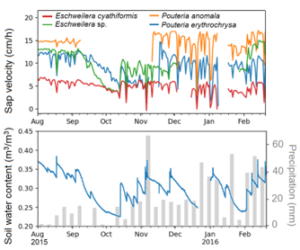Soil moisture thresholds of sap velocity.
The Science
Transpiration is the process of water moves through a plant from soil to atmosphere. In humid tropical rainforest region, soil water is recharged during the wet season to support dry season transpiration. Therefore, transpiration is often considered to be light- but not water limited in humid tropical rainforests. However, it’s not clear whether the tropical rainforests with abundant water will become water limited under extreme climate conditions. We used field data to examine dynamics of transpiration, soil water, and meteorological variables during the record-breaking 2015-16 El Niño drought in Central Amazon. We found a shift from light- to water-limitation of sap velocity, and identified a soil moisture threshold of water limitation in Central Amazon.
The Impact
This study suggests a progressively critical role of soil moisture under a drier future. This could happen in Central Amazon and other places that we previously thought have plenty of water. The soil moisture threshold provides a crucial benchmark to test and improve model simulations of future land-atmosphere feedbacks in Amazon under climate change, which are currently inadequate.
Summary
We measured sap velocity, soil water content, and meteorological variables in an old-growth upland forest in the Central Amazon throughout the 2015-16 drought. We found a rapid decline in sap velocity and in its temporal variability during the drought, accompanied by a marked decline in soil moisture and an increase in temperature and vapor pressure deficit. To understand water or light limitation, we examined the covariation of sap velocity with soil water content and net radiation using partial correlation analysis. We found sap velocity was largely limited by net radiation during normal dry seasons, but it shifted to be limited by soil water during drought. Next to identify the timing when this shift occurred, we used a moving window approach to conduct partial correlation analysis at every 10-day and examined how the coefficient changed during the whole period. We found the water stress started to occur in late August to early September in 2015. The soil moisture control continued throughout September, then became intermittent and disappeared after several rainfall events. During the strong water control period, the light control disappeared. We further identified the threshold of soil moisture at 0.33 m 3 /m 3 (around -150 kPa in soil matric potential).

Contact: Lin Meng, Lawrence Berkeley National Laboratory, Postdoc researcher, linmeng@lbl.gov
Funding
This work is supported by the Next Generation Ecosystem Experiments-Tropics (NGEE-Tropics), as part of DOE’s Terrestrial Ecosystem Science Program – Contract No. DE-AC02-05CH11231. We would like to thank the Large Scale Biosphere-Atmosphere Program (LBA), coordinated by the National Institute for Amazon Researches (INPA), for the use and availability of data, for logistical support and infrastructure during field activities.
Publications
Meng, Lin, et al. “Soil moisture thresholds explain a shift from light-limited to water-limited sap velocity in the Central Amazon during the 2015-16 El Niño drought.” Environmental Research Letters (2022), 17: 064023. https://doi.org/10.1088/1748-9326/ac6f6d